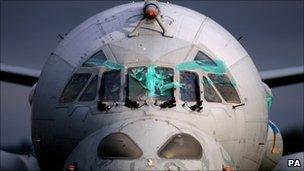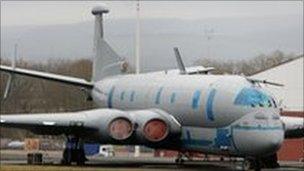Sadness as scrapping of £4bn Nimrods gets under way
- Published

A Nimrod awaits its fate
In a distant corner of a fenced-off site in Cheshire a fleet of Nimrod MRA4 warplanes which cost taxpayers more than £4bn are being turned into scrap.
The dismantling process is taking place far from public view. Workers spent two days erecting screens around the aircraft.
Small sections can be still glimpsed above the barriers, but that won't be the case for long. Private salvage companies started work breaking up the first of the planes, and already wings and parts of the fuselages have been ripped apart.
Operating costs
Campaigners fighting an 11th-hour campaign to save the jets describe the programme to cut up them up as an act of vandalism on an industrial scale.
The speed of the dismantling programme is in stark contrast to the long and convoluted programme to build the planes in the first place. The contract was originally signed more than 10 years ago.
Campaigners agree there were repeated delays and cost-overruns. But they argue that the MRA4 is now a world-class jet. They say getting rid of them in such an irreversible way doesn't make financial sense.
That scrappage programme will cost £200m. That's also what it would have cost to get all nine aircraft to a point where they could have been handed over to the MoD.
But it's the future operating costs which have driven the government's decision to cancel the planes. They say taking the Nimrod out of service will save £2bn over 10 years.
Dai Douglas built up 5,000 flying hours flying on Nimrods. He argues the sums being used by the government "just don't add up", and he says he and many of his former Royal Air Force colleagues feel betrayed.
Mr Douglas and many others I spoke to, including a former Nimrod captain with many years experience, worry that the military assets being used in place of the Nimrod are not as capable.
He believes that search and rescue operations could be compromised by the lack of Nimrod capability and claims that "it will only be a matter of time before lives are lost".

The Nimrods were assembled at BAE Systems at Woodford in Cheshire
Union anger
Workers and union officials at the site in Cheshire where the latest version of the plane was being built are also angry.
One union official said to me that they were trying to save jobs and trying to save the UK aircraft industry. It had also, he said, become a "crusade because we know what the planes can do. We know how the decision to scrap them will impact on the security of the country".
Campaigners trying to reverse the decision are calling on David Cameron to pause the dismantling programme, perhaps even mothball the planes for three or four years until the government can really prove the decision makes financial and strategic sense.
They point out the planes are nearly finished and have been paid for and they suspect the MoD will ventually end up buying US planes to take on the many and varied roles the Nimrod has historically performed.
Government ministers say they have sought to mitigate the gap in capability through the use of assets such as Type 23 Frigates, Merlin helicopers and Hercules C-130 aircraft.
They also say they are now developing longer-term plans to mitigate the impact of cancellation on continuing military tasks and capabiliies.
They also make clear that although the decision to cancel the Nimrod MRA4 was difficult, it will not be reversed.
So the campaigners fear that a fleet of nine aircraft that was a decade in the making could now disappear within a matter of weeks.
- Published27 January 2011
- Published27 January 2011
- Published26 January 2011
- Published21 January 2011